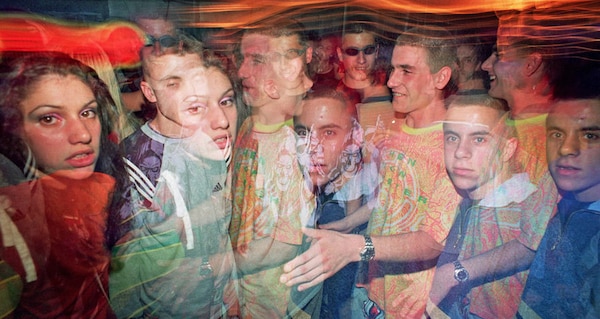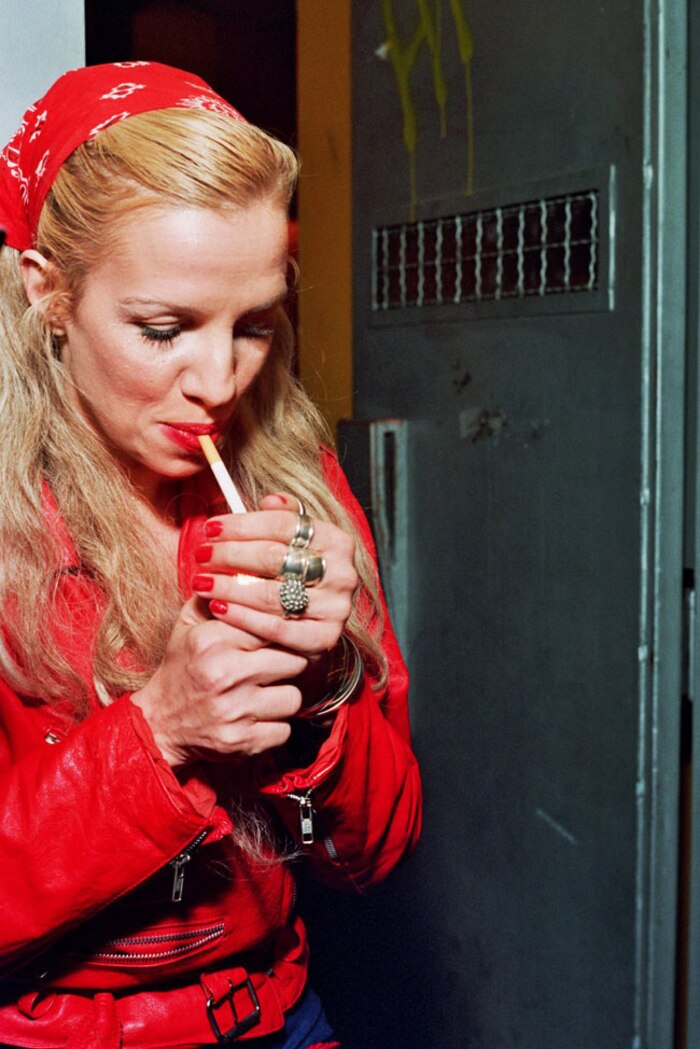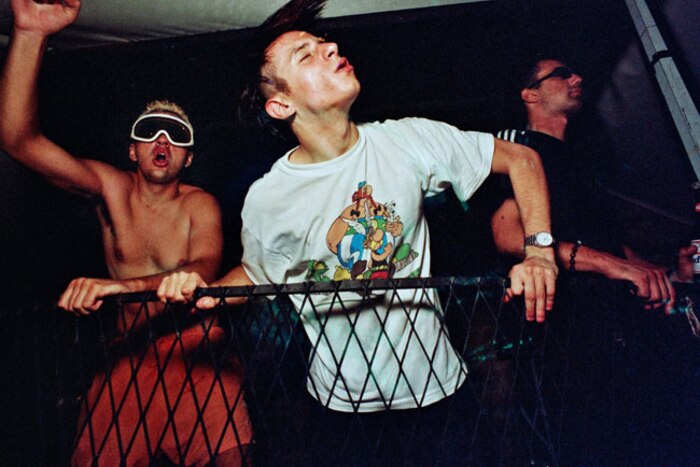Nightclubbing: Belgrade’s Industria

Vuksa Velickovic tells the story of how, as war raged around them, one Serbian club became more and more wild.
You’ve probably heard it already: Belgrade is Eastern Europe’s “ultimate party destination.” Unlike the “over-polished” Prague or Budapest, it is a place beaming with “realness” and subcultural flair, its nightlife apparently closer to that of Berlin than Bucharest. But it would be unfair to reduce the Serbian capital’s reputation solely to the media hype of Lonely Planet and New York Times articles. Some twenty years ago, in times of violence and political repression, Belgrade was as much of a party haven as it is today. Only back then, it was a different kind of party.
Much of the story about Serbian clubbing boils down to one name: Industria. It was the club that defined a generation of Belgrade youth and permeated the consciousness of every party-goer that roams the city today. However, it was the socio-political context – alongside some hard-boiled techno and a few flamboyant characters that made it a very special place indeed. The days when bullets were fizzing around in nightclubs, and gangs of thugs adorned in gold chains patrolled the streets will be remembered as some of the darkest in recent Serbian history. Oddly enough, in a bizarre interplay of urban idiosyncrasies, they were also Belgrade’s most extravagant.
At the peak of Milosevic’s power, Industria was opened.
A bit of background: In 1994, Serbia is run by Slobodan Milosevic and his oligarchic entourage with the generous help of the military, contract killers and gangsters. The country is not officially at war, but it sends troops mixed of conscripts and paramilitary divisions to neighbouring Bosnia & Herzegovina and Croatia. Sarajevo is effectively under siege and the Srebrenica massacre is less than a year away. Internally, the government is wrestling with the largest economic inflation in Europe since 1930’s Germany; amidst UN sanctions and international isolation, petrol is sold on the black street market, as is pretty much everything else.
The regime keeps a tight grip on the national media through a network of fabrication and lies, and aside from the official propaganda, the cultural landscape is dominated by “turbo folk” – a hybrid music genre mixed up of Balkan folk, soft porn and fantasies of glamour, providing an artistic backbone to the regime’s nationalist ideology. It seemed as if decades of Belgrade’s vibrant urban culture have been swept away. The same year, at the peak of Milosevic’s power, Industria was opened.

After a bleak first season, new management took over and put the club on its feet. The “Cosmic” residence on Thursday nights, pioneered by DJs Boza Podunavac, Gordan Paunovic and Vladimir Janjic, featured a sophisticated blend of acid house and early techno, pretty much unimaginable in Belgrade up until then. If the competing Soul Food club around the corner was catering to the softer, funk crowd, Industria bercame the refuge for a more courageous clientele.
If you were a regular, coming to the club was no different then arriving home to your living room.
It had everything you would expect from a world-class underground club. Situated in a basement of a large city bookshop, the 400-strong venue was just about the perfect size, never too big or too small, scarcely decorated, with pulsating stroboscopes, a banging soundsystem and a cozy lounge area. If you were a regular, coming to the club was no different then arriving home to your living room. Especially on a Sunday night. It also boasted one of the most charismatic door people in the history of clubbing: Loona Loo, today a well-known Belgrade TV journalist, whose cult status within the Industria’s provenance was only surpassed by the legendary “baba sera” (literally, “shit granny” – the old lady who’d supply additional toilet paper in the bathroom to needy clubbers).

After two steady seasons, in 1997, a younger, more energetic crowd was about to step in. And they needed a heavier sound. Kids brought up on a hefty diet of turbo folk and nationalist propaganda, were switching to hardcore techno. Teenage Techno Punks, a DJ duo made up of Marko Nastic and Dejan Milicevic who were yet to reach their drinking age at the time, quickly developed a cult following.
For the first time in Belgrade, 18-year olds were playing music for 18-year olds. Nastic’s straight-forward 4/4 techno set the pace for the city’s early electronic scene, while his technical competence in mixing earned him a God-like status in the eyes of fellow teenagers squeezed around the decks, following their idol’s every move in sacred devotion. Around this time, the parties were ending at 6 or 7 in the morning and Industria’s energy was soon to be channeled through the city’s repeating mantra of harder, faster, stronger.
Industria was the meeting point, a breeding ground if you wish, which could have turned your every all-nighter into an act of political resistance.
While escapism was part of Milosevic’s package, one should not underestimate the political potential of Belgrade’s youth. After all, the city created a public disobedience model for all subsequent revolutions to this day from Ukraine to Egypt – initially through three months of continuous protest in the autumn of 96-97 and, finally, in October 2000 when Milosevic himself was toppled. One of the most exciting things about Otpor – the student movement that proved instrumental in bringing down the regime – was the fact that its creative pool was not comprised of political managers but restless, creative spirits who popped pills on weekend nights. For many of them, Industria was the meeting point, a breeding ground if you wish, which could have turned your every all-nighter into an act of political resistance.
On the other hand, style and social leverage were always more important for the Belgrade youth than being part of any political agenda or cultural movement. That’s partially the reason why Industria never lived up to its political promise. After 1998, the atmosphere in the club started to change. Some of the frequent guests were not only Belgrade’s future officials, artists and independent-media personas, but increasingly, dubious, grim characters.

Industria opened its doors for the last time in 1999, the same year NATO bombed Serbia for almost three months. Belgrade was under curfew and drones were hitting targets in the city centre. DJ Vadim of Ninja Tune had to cut a gig short and play an encore the following day because of chronic power shortages. An apocalyptical mood was descending upon the country. When the chief of Milosevic’s special secret police units started frequenting the club and waving his gun out of amusement at teenagers, it become clear the party was over. A year later, both the regime and Industria would be assigned to the annals of history.
When the chief of Milosevic’s special secret police units started frequenting the club and waving his gun out of amusement at teenagers, it become clear the party was over.
As journalist Vojislav Tufegdzic noted in his 1995 book Crime That Changed Serbia, Belgrade in the ’90s “epitomised Chicago of the ’20s, the economic crisis of Berlin of the ’30s, the intelligence intrigues of Casablanca of the wartime ’40s, and a cataclysmic hedonism of Vietnam of the ’60s.” Milosevic himself ruled with a combination of iron fist and a certain authoritarian permissiveness perhaps most reminiscent of the Roman emperors. As long as his own power was not questioned, he allowed you to play as much as you wanted. But unlike some of the more flamboyant Neros and Caligulas, he would rarely step into the public, preferring to command from the TV screen like a true Orwellian character. Ubiquitous, but nowhere to be seen. He’d also let you imagine that everything you did – even dancing – was subversive.
After the regime was ousted, there was little left for subversion. Corporate money started rolling into Serbian clubbing, and the management of Industria decided it was time to move on. The club lived through one unsuccessful attempt at reanimation, and that was it.
In the meantime, Belgrade’s dance scene succumbed under the wave of sponsored entertainment and mass benders of all sorts. The city at last became “the ultimate party destination” everyone was talking about, at least in the eyes of the western tourist, fascinated by the endless strip of riverboat clubs and access to beautiful women. But Belgrade’s underground nightlife – the one that once spelled more than a Friday night binge – has been in a steady decline over the last several years. Some say the city has lost its flair, but everybody will tell you it can always spark when least expected. Maybe it’s time to start over again. Belgrade’s urban culture is ripe for a renaissance. Or even better, a revolution. It’s never too late.
Header image © Srdjan Veljovic

